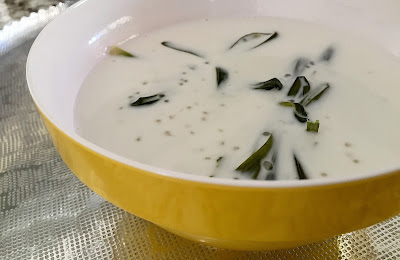When my older daughter Nhã-Hân started eating solid food, she had no problem with eating any type of fish. When she was four, she had a pet gold fish. A few months later, we built a koi pond and decided to give the gold fish away to our cousin. Since then, she refuses to eat fish altogether. We couldn't figure out why and one day she told us it was because we gave away her pet. Go figure.
Our family loves fish and I want her to eat healthy. Every meal with fish requires a herculean effort to coax her and eventually she would - very begrudgingly of course. She's learned to be extremely selective and negotiates for only salmon. What's a mom to do?
So now I have a tall order to create salmon recipes to please my picky eater and keep her excited about eating fish.
Cá Hồi Chiên Tỏi Tây (Pan-Seared Salmon with Sauteed Leek) is one of the salmon dishes that she loves. For her, the sauteed leeks that's served along with the seared salmon is the main attraction. Eating that with steamed rice is beyond satisfaction. Anything to get her to eat the salmon.
Leeks, like garlic and onions, belong to a vegetable family called the Allium vegetables. With a more delicate and sweet flavor than onions; leeks add a subtle touch to salmon without overpowering the other flavors that are present.
This is a very simple but delicious way to prepare fresh salmon using just a few ingredients from your pantry.
*
RECIPE: Pan-Seared Salmon with Leek
Ingredients
1-1.5 pounds Salmon
1 Leek
1 1/2 tablespoons Lime Juice
3 tablespoon Maggie Soy Sauce
1 tablespoon julienned Ginger Root
1/2 teaspoon Ground Pepper
Olive Oil
*
Directions
Preparing Sauce
Ginger - cut ginger into fine julienne, make one tablespoon. Set aside.
Leek - use only the white and light green part of leek. Slice leek thinly, make one cup. Set aside. You can save the dark green leaves for cooking soup, stew, stock to add flavor and removed before serving.
In a mixing bowl, combine ginger, leek, lime juice, soy sauce, and pepper, and mix well. Let it sit for about 5 minutes so that all the flavors release and blend well.
*
Preparing Salmon
Cut salmon into large pieces. Set aside.
*
Marinating Salmon
*
Searing Salmon
Remove salmon from the the sauce, and leek. You don't want to fry the leek with salmon because the leek will be burnt by the time the salmon is cooked.
Bring a frying pan over medium high heat. Add about 2-3 tablespoons of olive oil. Once the oil is hot, gently place the salmon onto the pan. Do not flip the salmon right away as it will break apart. Let it cook one side until crisp and golden crust then flip over to cook the other side.
Salmon is delicate and very easy to overcook even thick fillets of salmon will cook very quickly. Remember that the fish will continue to cook once it’s off the heat, so you want it to be slightly underdone when you take it off the heat. Salmon tastes better on the rare side, when the center is still slightly pink.
Remove salmon from the frying pan. Place leek mixture into the frying pan and cook for a minute. Don't cook the leek too long as the water from the soy sauce will evaporate resulting in salty mixture.
*
Presentation
Serve salmon with sauteed leaks over steamed rice and garnish with cucumber and tomatoes.
Eat Well. Be Healthy!














































































